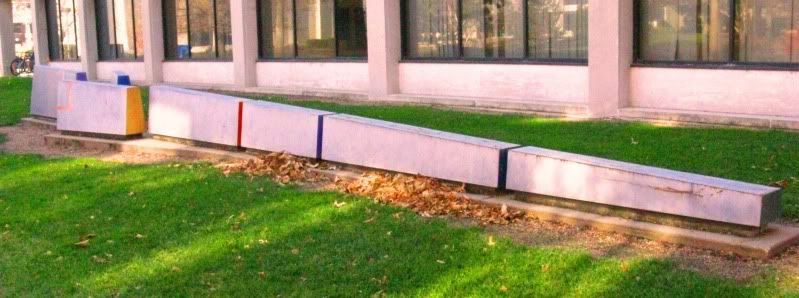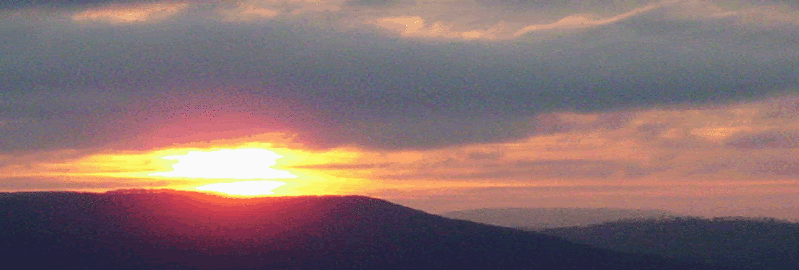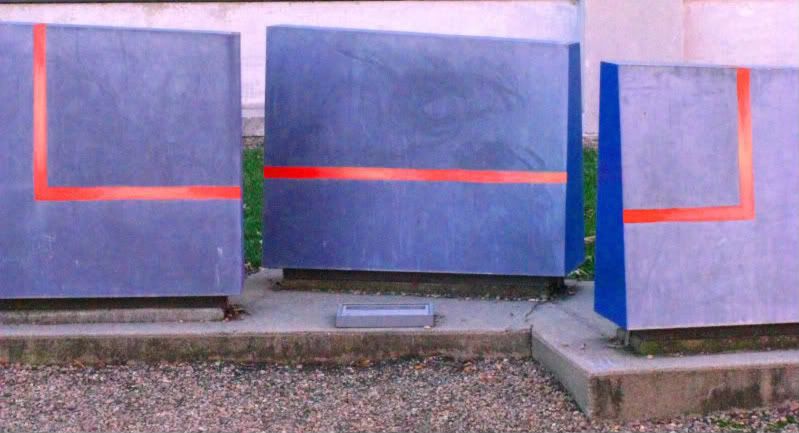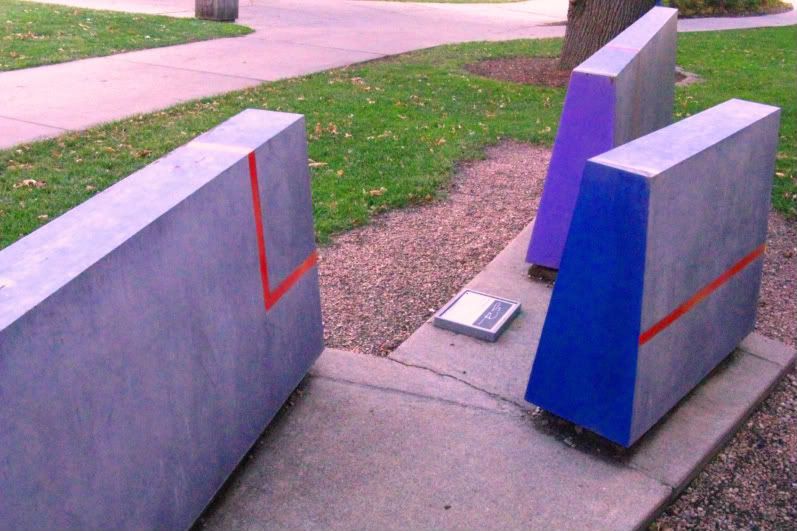Author's Note
I'm usually have little interest in art objects. I appreciate them for their aesthetic value and enjoy spending time at museums browsing the collections, but I have never spent a prolonged period of time examining a single artwork before. Because of my limited experience, I initially thought that the third and final writing project (WP3) would be the most difficult. These feelings were compounded when we were randomly assigned a sculpture from the Sheldon Sculpture Garden. Although I've had class in the part of campus where the Sculpture Garden is located, I was assigned a sculpture that I didn't even know existed and had never even noticed before! In conducting research on the sculpture itself, I found little information about the artist, and even less information about the object.
This combination of variables led to my decision to accept the challenge of using my newly acquired rhetorical analysis skills to engage with my assigned art object in a more creative way. "Option 2" seemed like a good idea at first, but it proved to be more difficult than I estimated. How could I include a description of the sculpture, observations and reflection, and an analysis using the aesthetic paradigm of intensification or negativity in a personal letter format?
This combination of variables led to my decision to accept the challenge of using my newly acquired rhetorical analysis skills to engage with my assigned art object in a more creative way. "Option 2" seemed like a good idea at first, but it proved to be more difficult than I estimated. How could I include a description of the sculpture, observations and reflection, and an analysis using the aesthetic paradigm of intensification or negativity in a personal letter format?
I began with a statement of purpose in the same manner that I had done two times before. I was certain to include specific rhetorical techniques that the composer of the art object employed and the argument that I interpreted. Through this statement, I was able to focus my interpretation of the purpose of this artwork as type of agent of change. This is supported by my observation that "When viewed through certain rhetorical lenses, we are able to determine that there is a unifying concept that all possible argument can be represented by: change is both inevitable." I paired this concept with my investigation of the art object through the aesthetic-conceptual paradigms of intensification and negativity.
The biggest obstacle that I met during the first draft was concluding this letter in a way that was natural and authentic to the genre in which I was writing. I realized that I couldn't just summarize what I was saying, and but I did need to provide some modicum of closure for myself and my audience. I decided to continue the idea of using negativity within the composition to represent meaning when I concluded with, "Even within the silence we can find music, and even within a space devoid of material we can find meaning." I connected this thought to what I interpreted to be the main argument that the art object was making about the inevitability of change.
With the help of a peer review, I explicitly developed the idea of intensification from my first draft to my second draft. In the first draft, I briefly mentioned how the colors that were wedged into the composition were "suggestive of the colors that the sun creates as it nears the horizon," but I further developed this idea to include how "these features helped to intensify [the] significance" of the sculpture. My detailed description supported this concept, and I was able to produce a more cohesive final product.
Reading the letter to my sculpture was an important part of the editing process. Reading a letter out loud exposes many grammatical errors and awkward turns of phrase. Figuring out a way to imitate my sculpture, which is non-organic and abstract, proved difficult. Eventually, I decided to wedge myself into the negative space within the composition to represent the important aspects of the art object. Overall, I really enjoyed this project. I am glad I decided to accept the more creative challenge to complete my semester-long experience in rhetorical analysis.
The biggest obstacle that I met during the first draft was concluding this letter in a way that was natural and authentic to the genre in which I was writing. I realized that I couldn't just summarize what I was saying, and but I did need to provide some modicum of closure for myself and my audience. I decided to continue the idea of using negativity within the composition to represent meaning when I concluded with, "Even within the silence we can find music, and even within a space devoid of material we can find meaning." I connected this thought to what I interpreted to be the main argument that the art object was making about the inevitability of change.
With the help of a peer review, I explicitly developed the idea of intensification from my first draft to my second draft. In the first draft, I briefly mentioned how the colors that were wedged into the composition were "suggestive of the colors that the sun creates as it nears the horizon," but I further developed this idea to include how "these features helped to intensify [the] significance" of the sculpture. My detailed description supported this concept, and I was able to produce a more cohesive final product.
Reading the letter to my sculpture was an important part of the editing process. Reading a letter out loud exposes many grammatical errors and awkward turns of phrase. Figuring out a way to imitate my sculpture, which is non-organic and abstract, proved difficult. Eventually, I decided to wedge myself into the negative space within the composition to represent the important aspects of the art object. Overall, I really enjoyed this project. I am glad I decided to accept the more creative challenge to complete my semester-long experience in rhetorical analysis.
Final Draft
I've been observing you for some time now, being careful to always keep my distance so I could continue to watch you with studied intent. I am usually awkward and unsure when it comes to art objects and I'll admit, I don't have much experience interacting with your genre of visual art. So when I found out I had been given an opportunity to meet with you, I "googled" you in order to prepare myself for our first encounter. (As an aside, I will have to commend you on your minimal web presence--it is quite an amazing accomplishment to remain "under the radar" during this digital age.) After much anticipation on my part, we formally met one sunny afternoon in late November--I'm not sure if you remember it specifically. Over the last few weeks our relationship has grown, and I now feel comfortable enough with you to share some of my observations. I also wanted to address my interpretation of the argument you've been making. Finally, I want to discuss your use of intensification and negativity. We'll think of it as a trip down memory lane...
While I've come to know you as V.W., you are titled "Variable Wedge" and call the Sculpture Garden of the Sheldon Museum of Art home. Initially, I felt that we had a connection because of our shared background; you were constructed from 1982-1983 and now reside in Nebraska, I was born in 1983 and now live in Nebraska as well. Sam Richardson, who was the artistic mastermind behind your design and creation, has a history of creating breathtaking landscape art works--both in the genres of painting and sculpture. I hope you realize that you owe a lot to him; he wisely chose to fashion you from COR-TEN steel. I consider this as a wise decision because he realized that the use of "weathering steel" would prevent you from being subjected to the sometimes severe environmental conditions. I assume sometimes you might be resentful of his decision; because you are made of a steel alloy you are incapable of eroding and this has made you cold, hard, and unchanging. You must realize that he was only trying to protect you. If you were made of weaker material your purpose would be lost, as your appearance would diminish over time. And face it--your looks are one of your best qualities. I, for one, am appreciative of Sam's carefully chosen choice of material, as well as the deliberate choices he made in your design.

One of the first things I noticed about you was your expanse. There are seven separate parts of you are aligned to make one sprawling art form, extending over fifty feet. (IMPRESSIVE!) From a distance, your arrangement is reminiscent of a sprawling mountain range, creating a tribute to Sam Richardson's landscape training. When I first saw you in person that fateful day in November I thought to myself, "It is obvious that Variable Wedge is a dead ringer for purple mountain majesties. Case closed." But what I didn't realize is that while you paid homage to nature, you also had an ulterior motive, hidden from most of your unsuspecting viewers. You had been inserted into the natural environment that surrounds you while representing a natural landform. Viewing your insertion through the lens of intensification gave me an exaggerated interpretation of your meaning. You have been wedged into the natural environment by man, creating a visual breach that serves as a permanent reminder of the delicate relationship between man and nature.



Deepest regards,
Ayana
Student / Art Observer / Friend